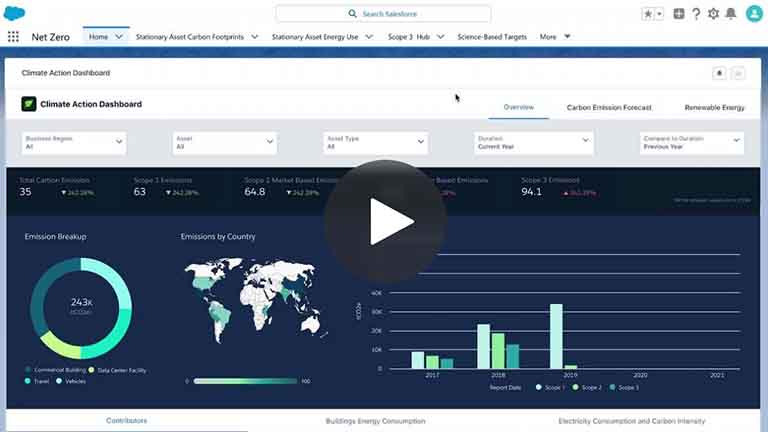The Business Guide to Carbon Accounting
Why should a business account for its carbon?

What is carbon accounting?
Carbon accounting is the process by which organizations quantify their greenhouse gas (GHG) emissions so that they may understand their climate impact, set goals to reduce their emissions, and identify risks and opportunities for the business. In some organizations, a company’s carbon footprint is also known as a “carbon inventory” or a “greenhouse gas inventory.”
Carbon accounting is the foundation for implementing meaningful climate action in your organization. Once you take inventory of your GHG emissions, you can start to make carbon reduction plans that support your sustainability strategy.
What are greenhouse gas emissions?
The Kyoto Protocol, the international treaty committing countries to reduce GHG emissions, identifies six types of greenhouse gases, of which three are most common for companies: carbon dioxide (CO2), methane (CH4), and nitrous oxide (N2O).
Greenhouse gases trap heat, which sustains life on Earth by allowing the sun to warm the planet and prevent the warmth from escaping into space. However, an increase in GHG emissions, largely caused by human activity, is disrupting the atmospheric balance that maintains our climate, resulting in extreme global effects on ecosystems, economies, and communities. These negative impacts include extreme heat, major wildfires, mega-storms, and rapidly rising sea levels.
The world uses the common unit CO2e, or carbon dioxide equivalent, to simplify discussion around GHG emissions. The EPA defines CO2e as the number of metric tons of CO2 emissions with the same global warming potential as one metric ton of another GHG. In other words, CO2e refers to the impact from all GHGs, normalized and described in terms of CO2 impact. By referring to the impact of all GHGs in terms of CO2e, we can make direct comparisons among various GHGs.

How should you categorize emissions?

Step 1. Assemble your team
Facilities management
Finance
Accounting
Travel
Human resources
IT/Infrastructure
Legal
Procurement
Product development

Step 2. Conduct Your Greenhouse Gas Footprint
The first step in calculating your GHG footprint is identifying what the boundary of your calculation will include. Companies often align with the methodology outlined by the Greenhouse Gas Protocol, which explains how companies should identify which assets to include for scope 1 and scope 2 emissions and how to categorize and frame their scope 3 emissions.
For scope 3 emissions, you should capture emissions data for all your direct, or Tier 1, suppliers. We refer to these as upstream emissions. If you produce a finished product or a service that gets sold to a customer with no further chain, you should collect emissions from distribution channels and resellers, also known as downstream emissions. If you produce intermediary goods that go through further processing (e.g., raw copper, which gets produced into copper sheets, which get produced into copper wire), then you want to track emissions until your product becomes a final product. If all companies do this, that reduces the amount of upstream tracking required.
This explanation ties most closely to manufacturing, but the same principle of tracking one step upstream and all steps downstream can be applied to other industries as well. Regardless of the industry, companies must define and disclose their reporting boundaries, which may include the GHGs themselves, their sources, the reporting period, the geography, or the business structure or unit.
Once you’ve established your boundaries, you can begin data collection. But collecting the activity data that serves as the foundation for a GHG footprint is not simple. For scope 1 data, you’ll need to find information on natural gas and diesel used onsite, as well as fuel logs for owned vehicles. Scope 2 data largely consists of electricity and natural gas bills, but finding these can be challenging, especially for smaller offices. Sometimes companies end up needing to fill in the gaps when certain data records simply aren’t available by estimating impact using headcount or square footage.
Scope 3 data is by far the most complex. Many companies collect as much actual data as possible — travel data, for example — and then rely on estimates to fill in the gaps where source data is especially challenging to capture. In the end, it’s most important to do the best you can with what you have and to commit to continued efforts to improve data quality and data consistency over time.
The raw data you gather will not come to you as carbon emissions data. Data for a flight, for instance, might include the price, distance traveled, ticket class, and aircraft type. Turning that data into metric tonnes of CO2e requires a series of calculations and conversions. In some cases, there are a few ways to complete these calculations, and it’s important to carefully consider which emissions factors and methodologies will provide the most accurate, complete picture of your GHG emissions.
For electricity data, two different methodologies are recommended: the location-based method and the market-based method. Location-based emissions communicate the carbon impact of electricity based on the local electric grid that each building is physically connected to. The market-based method allows companies to account for renewable energy purchases they have made (for example, through a power purchase agreement), meaning that their total emissions will be lower. Because these two methods each tell an important part of a company’s GHG impact story, the GHG protocol recommends that companies calculate their emissions using both of these methods and share both side by side in GHG footprint reports.
Internal reviews are a critical step in the GHG inventory process. The intent of these internal reviews is to ensure that the data and methodology match the on-the-ground realities for the business and that the data sets are complete.
Next, it’s best practice to engage an independent third party to complete a full review or even an audit of the GHG inventory to verify its accuracy. In spirit, this is very similar to a third-party audit of the financial records and claims of a publicly traded company. Reviews are sufficient for now, but full audits will eventually be among the requirements.

Step 3: Streamline the Process
Companies that follow these steps manually require up to six months to create a trustworthy report on their carbon emissions. For years, companies have relied on spreadsheets, estimations, and incomplete data to create reports that were not particularly accurate and didn’t necessarily paint the full picture of a company’s carbon footprint. Some simply omitted entire emission categories because the effort required to capture and calculate the data was greater than the benefit of including it in their report.
But there is an easier, faster, more accurate way to account for your company’s carbon emissions. Net Zero Cloud pulls your emissions data in automatically, so you get an accurate, timely view of all areas that contribute to your carbon footprint. It’s a complete sustainability management platform that comes with analytics dashboards that help users make sense of their organization’s carbon inventory. These dashboards are powered by Tableau and help users drill deep into their organization’s energy usage patterns and carbon emissions intensities to find areas on which to focus carbon reduction efforts.
Carbon accounting can be an incredibly resource-intensive process, taking time, expertise, and budget, but it doesn’t have to be. Net Zero Cloud enables organizations to quickly track, analyze, and report reliable environmental data to help your company reduce its carbon emissions. It has globally conforming emission conversion factors built in, allowing you to instantly translate energy use into carbon emissions. The data is also automatically categorized as scope 1, 2, and 3 emissions, so you know exactly where to concentrate your carbon-reduction efforts.

Convert your data into emissions.
More resources

Ecopreneurs are leadeing a new age of net zero business

Roadmap to net zero for financial institutions























